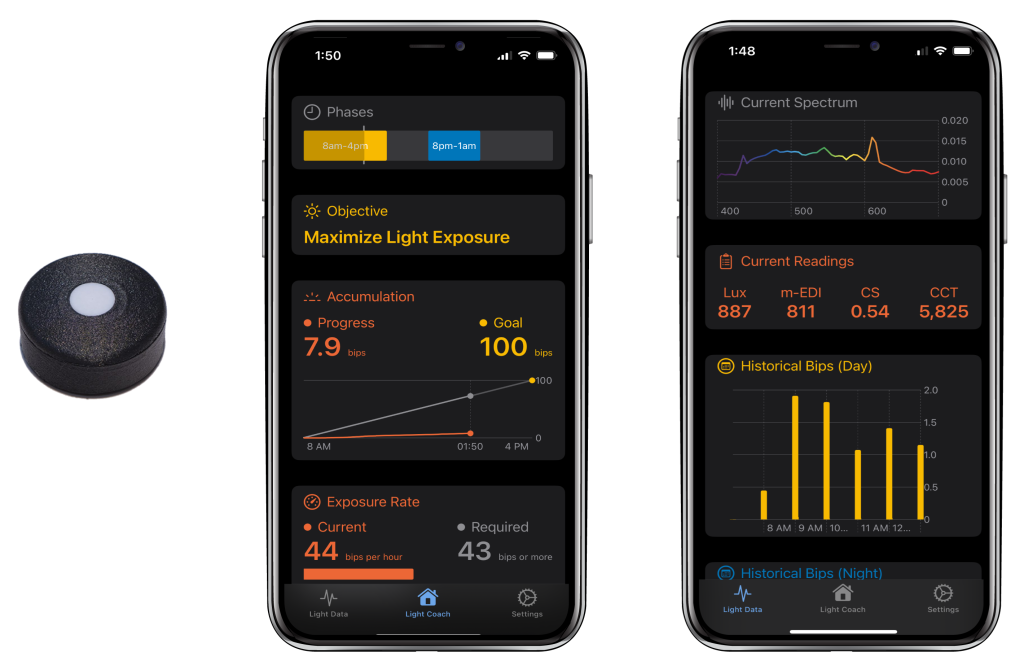Investigators:
Erik Page, Blue Iris Labs
MassAITC Cohort: Year 2 (AD/ADRD)

Project Accomplishments: The Blue Iris Labs pilot study investigated how personal light exposure affects sleep quality using a new wearable light sensor called the Speck. Conducted from mid-2023 to early 2025, the study involved 31 participants who wore the Speck and Apple Watch for 30 or more days to test protocols for use and data analyses. The Speck collected detailed light exposure data, while sleep metrics were gathered via Apple Watch. The study confirmed that bright light in the morning and low light at night were associated with better sleep, aligning with existing research. Despite some technical and compliance challenges, the Speck performed well in real-world conditions, and participants generally adhered to the protocol.
The study also explored individual differences in light-sleep relationships and began developing models to explain these variations using demographic and behavioral data. The findings support the feasibility of using the Speck in long-term, real-world studies and suggest it could be a valuable tool for monitoring and improving sleep health, especially in aging populations. The pilot laid the groundwork for future research, including studies with Alzheimer’s and dementia populations, and highlighted the need for standardized sleep tracking tools and more diverse participant recruitment. Results from this study will inform updates to the Speck Connect mobile app, which provides “light coach” recommendations to people with Alzheimer’s disease and related dementias to help them improve their circadian entrainment and sleep quality. The success of this study is expected to accelerate the commercial launch of the Speck and its companion app, Speck Connect.
Initial Proposal Abstract: Light is the primary regulator of human circadian rhythms. Through our prior NIH-funded research, we have developed and commercialized the first wearable light exposure devices that gather all physical properties of light thought to impact circadian health. Sleep quality is a critical measure of circadian health. Sleep trackers are in mass commercial use and are improving in accuracy and precision. Here, we seek to identify correlations between what are arguably the most important environmental inputs (light exposure) and health outcomes (sleep) in circadian science.
We propose gathering data using commercially available devices (i.e., our light exposure tracker and leading commercial sleep trackers) and machine learning techniques to identify the light exposure parameters and patterns that correlate most strongly with measured sleep metrics. We propose to collect light exposure and sleep metric data from at least 15 (non-AD/ADRD) individuals for at least 50 days per individual using methods that could scale commercially.
This pilot test is primarily intended to validate the methodology related to correlating light exposure and sleep metric data rather than to directly estimating the nature or magnitude of these correlations. These data will be analyzed for correlations between light exposure inputs and sleep quality outputs. Specifically, we propose to identify how the intensity, spectrum, and timing of light exposure of individuals correlate with their sleep duration, sleep phases, and sleep scores, as reported by various commercial sleep trackers.
We further propose to investigate how these correlations vary between individuals, seeking to identify potential parameters that influence interpersonal variations, such as demographic differences and differences in personal light sensitivity. If the methods proposed in this pilot are validated, the study results are expected to inform the design of a larger clinical trial that includes participants who have Alzheimer’s disease (AD) or related dementia (ADRD), with the aim of identifying specific light exposure patterns associated with specific, quantifiable improvements in sleep metrics in these populations.
Outcomes:
- Poster Presentation: Alzheimer’s Association International Conference 2025 – Technology and Dementia Preconference
 Title: Using Light Exposure to Improve Sleep and Circadian Health for People with Dementia Authors: Erik Page, William Huang, Dave Harris, Hank Ibser
Title: Using Light Exposure to Improve Sleep and Circadian Health for People with Dementia Authors: Erik Page, William Huang, Dave Harris, Hank Ibser - Poster Presentation: a2 National Symposium 2025
 Title: Using Light Exposure to Improve Sleep and Circadian Health for People with Alzheimer’s Disease Authors: Erik Page, William Huang, Dave Harris, Hank Ibser
Title: Using Light Exposure to Improve Sleep and Circadian Health for People with Alzheimer’s Disease Authors: Erik Page, William Huang, Dave Harris, Hank Ibser - Poster Presentation: a2 National Symposium 2024
 Title: Speck: A Sensor for Healthier Lighting Authors: William Huang, Erik Page, Hank Ibsen, Dave Harris
Title: Speck: A Sensor for Healthier Lighting Authors: William Huang, Erik Page, Hank Ibsen, Dave Harris - Patent: Circadian Sensor System
 US Patent office granted a patent to Blue Iris on March 19, 2024 for their Circadian Sensor System. A circadian health system (CHS) provides for improving the health of Alzheimer’s patients and other persons by controlling their exposure to circadian lighting. Circadian sensor devices (CSDs) are distributed in a living… Read more: Patent: Circadian Sensor System
US Patent office granted a patent to Blue Iris on March 19, 2024 for their Circadian Sensor System. A circadian health system (CHS) provides for improving the health of Alzheimer’s patients and other persons by controlling their exposure to circadian lighting. Circadian sensor devices (CSDs) are distributed in a living… Read more: Patent: Circadian Sensor System - New Product Version Launch: Speck Light Exposure Sensor
 Blue Iris has commercialized a new version of the Speck light exposure sensor. The new version is functionally similar to the previous version but has been modified for increased field robustness (e.g., more resilient power supply, stronger case, etc) and for manufacturing scalability. Source: Blue Iris Labs Product Page
Blue Iris has commercialized a new version of the Speck light exposure sensor. The new version is functionally similar to the previous version but has been modified for increased field robustness (e.g., more resilient power supply, stronger case, etc) and for manufacturing scalability. Source: Blue Iris Labs Product Page
